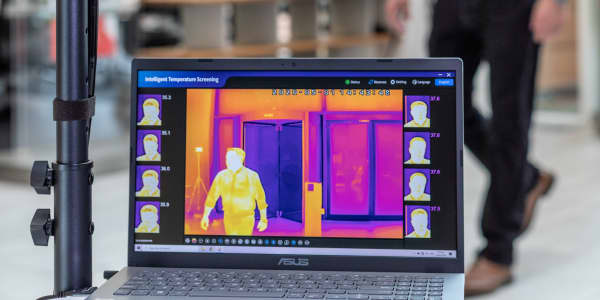As the coronavirus pandemic closed down offices around the world, it also put a stop to in-person business gatherings.
Large-format events such as the Adobe Summit, which each year hosts thousands of delegates in Las Vegas, moved online in May, while in Europe the five-day Cannes Lions advertising festival went virtual and rebranded as Lions Live in June.
So how can a business possibly recreate that kind of experience online?
In 2019, around 20,000 people attended SAP's Sapphire Now conference in Orlando for several days of discussion, networking and entertainment. "Our customers have come to value hearing from us, learning about … our strategy and our product road map, aligned to what they are trying to help solve," SAP's Chief Marketing Officer Alicia Tillman told CNBC by phone. "As we've operated through this crisis, there's been increased dependency on technology to help support business continuity," she added.
When the company realized the in-person element of its 2020 flagship event would have to be canceled due to lockdowns, the company set about "reimagining" it, and with only two months to go, switched it online. "I truly believe that we're scaling up," Tillman told CNBC, adding that the online event had more than three times the usual number of registrations (the virtual conference was free to attend this year, whereas it usually costs upwards of $1,000). SAP started publishing content in late April with a video series featuring the likes of author Malcolm Gladwell, NBA commissioner Adam Silver and beauty entrepreneur Jo Malone, with the aim of helping executives get through the pandemic. Then in June, the live element of Sapphire Now began, featuring new CEO Christian Klein (with some technical issues) and a live performance by Sting.
Far and wide
One benefit of going virtual is attracting a wider audience. While 70% of Sapphire Now delegates usually come from North America, for the virtual version SAP created 14 local events in various languages and time zones, with regional heads addressing their relevant markets.
Microsoft-owned LinkedIn also found a greater audience for its TransformHER conference when it moved online in June. The event, which started as an in-person initiative in 2018, aims to advance the careers of women of color who work in technology. Delegates heard from speakers such as Morgan Stanley's Vice Chair of global wealth management Carla Harris, and Claudia Romo Edelman, founder and CEO of the foundation We Are All Human.
Edelman and Harris would usually be speaking in front of 350 to 400 in-person attendees at LinkedIn's San Francisco office, but this year, hosting the event online meant it could reach people in places such as Morocco, the U.K. and Kenya. Harris urged attendees to consider whether they had "time, talent and treasure" to give to movements such as Black Lives Matter and the livestream had more than 62,000 views, according conference co-founder Ty Heath, who is also global lead of LinkedIn's think tank the B2B Institute.
Heath said the virtual format provided greater scale and therefore more action as a result, in an email to CNBC. "On the flip side, there is something special about coming together in person," she added. "It offers you a chance to network and have more personal connection and conversation at that moment," But this is made up somewhat by the chat function on video calls: "We loved seeing the reflective commentary, sharing of resources and encouragement on the livestream chat," she said.
Production values
Teresa Poggenpohl, a marketing consultant and former senior executive at Accenture, is used to presenting at and attending in-person events with high production values. But, she said, switching to being an online speaker isn't quite the same. "You don't have the body language, you don't have the eye contact," she explained.
Virtual events may however improve real-life conferences when they resume. Events organizers may be encouraged to film their speakers in a way that works better for a small-screen format, instead of the usual "dark room with a very small person," that videoed presentations sometimes produce, Poggenpohl suggested.
Poggenpohl spoke at the B2B Marketing Ignite USA 2020 conference in May, an event that had been due to happen in-person in Chicago but switched online using technology from software company Hopin. "It gave you a main stage, it allowed multiple breakouts to happen at the same time. It allowed 'networking,' … And then they even had a virtual expo (space) for the sponsors," she said.
Virtual events have also provided a boost to some businesses. Andrew Beranbom, CEO and co-founder of streaming platform First Tube Media, said that pre-pandemic, only around 5% of marketers considered live media as part of their promotional activity.
"We believe this will be closer to 90% due to the impact of Covid-19 and the need for brands to be agile," Beranbom told CNBC by email. First Tube Media worked with Mastercard to move concerts from singer Camila Cabello online during lockdowns, and also streamed a performance from country band Lady A (formerly Lady Antebellum) sponsored by tech companies Cisco and CDW in May, which attracted 2.2 million views.
Production values aside, organizers also need to bear copyright rules in mind when switching online, according to media and entertainment expert Gregor Pryor, a partner at law firm Reed Smith. "It's not just the 100 people you can see in a room watching a presentation, it's a potentially infinite number of people online, who can easily capture and share," he told CNBC by email. "While online events might seem less permanent, there's actually a much higher chance that any misdemeanors or breaches of copyright or online regulation will be captured or stored."




